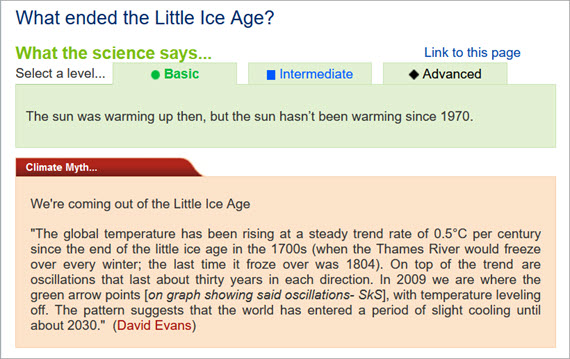At a glance - What ended the Little ice Age?
Posted on 14 May 2024 by John Mason, BaerbelW, Ken Rice
On February 14, 2023 we announced our Rebuttal Update Project. This included an ask for feedback about the added "At a glance" section in the updated basic rebuttal versions. This weekly blog post series highlights this new section of one of the updated basic rebuttal versions and serves as a "bump" for our ask. This week features "What ended the Little Ice Age?". More will follow in the upcoming weeks. Please follow the Further Reading link at the bottom to read the full rebuttal and to join the discussion in the comment thread there.
At a glance
Where were you in 2009? It seems an age ago now. Climate science denial was everywhere. Skeptical Science was just two years old. It was like whack-a-mole - as one myth was dealt with, more would pop up.
Among the talking-points emerging around that time was the one that global warming was simply the planet recovering from the Little Ice Age (LIA). The LIA was a period of regionally cold conditions, usually said to have occurred between 1350 and 1850. Glaciers in the European Alps reversed their decline and advanced. In London, UK, the tidal Thames froze over sufficiently for 'frost-fairs' to be held on the ice, between 1608 and 1814. Their frequency is often exaggerated; roughly one winter in ten would be a realistic estimate.
Why was it so cold? Here, time travel would be wonderful. In the absence of that, we have had to develop more ingenious ways of reconstructing what happened.
A key factor is the LIA's regional nature. Its most dramatic effects were in Europe and North America. That suggests there was an element of 'internal climate variability' involved. The latter term refers to how heat is moved around within Earth's climate system, as opposed to being added to or removed from it.
During the LIA there were 'external forcing' factors too - these are things that do add or remove heat from the climate system. There was an extended period of minimal Solar activity, known as the Maunder Minimum. However, the Maunder Minimum took place between 1637 and 1719, more than 200 years into the LIA. It cannot have caused the initial cooling.
There were several colossal volcanic eruptions during the LIA, such as Laki in 1783 and Tambora in 1815. The Samalas eruption on the Indonesian island of Lombok was also huge, but occurred in 1257, almost a century before the LIA started. Volcanogenic cooling episodes typically last just a few years, but they wouldn't have helped: Laki and Tambora likely prolonged the cold conditions.
Recent research is instead hinting that the LIA was triggered by a dramatic weakening of the Gulf Stream. That was caused by warm ocean currents penetrating far into the Arctic, causing a dramatic breakup of the sea-ice. Resultant ice-floes were 'exported' en-masse out into the North Atlantic, where they melted, generating cool freshwater. This process peaked around the year 1350. The overloading by all that cool freshwater disrupted ocean circulation patterns and a rapid regional cooling followed.
At the other end of the LIA, what warmed things back up? Firstly, the 1850 end-date is not necessarily reflected in temperature datasets. These show a steady warming trend that only emerged after 1910, steepening and becoming less interrupted after 1970. That is not a regional but global pattern, suggesting that unlike the LIA, an external forcing was dominant. There's one obvious one - our pumping out of greenhouse gases.
The year 2009 was full of predictions from well-known deniers that we were entering a cooling trend. Fourteen years on, there's no sign of that!
Please use this form to provide feedback about this new "At a glance" section. Read a more technical version below or dig deeper via the tabs above!
Click for Further details
In case you'd like to explore more of our recently updated rebuttals, here are the links to all of them:
If you think that projects like these rebuttal updates are a good idea, please visit our support page to contribute!































 Arguments
Arguments































Comments